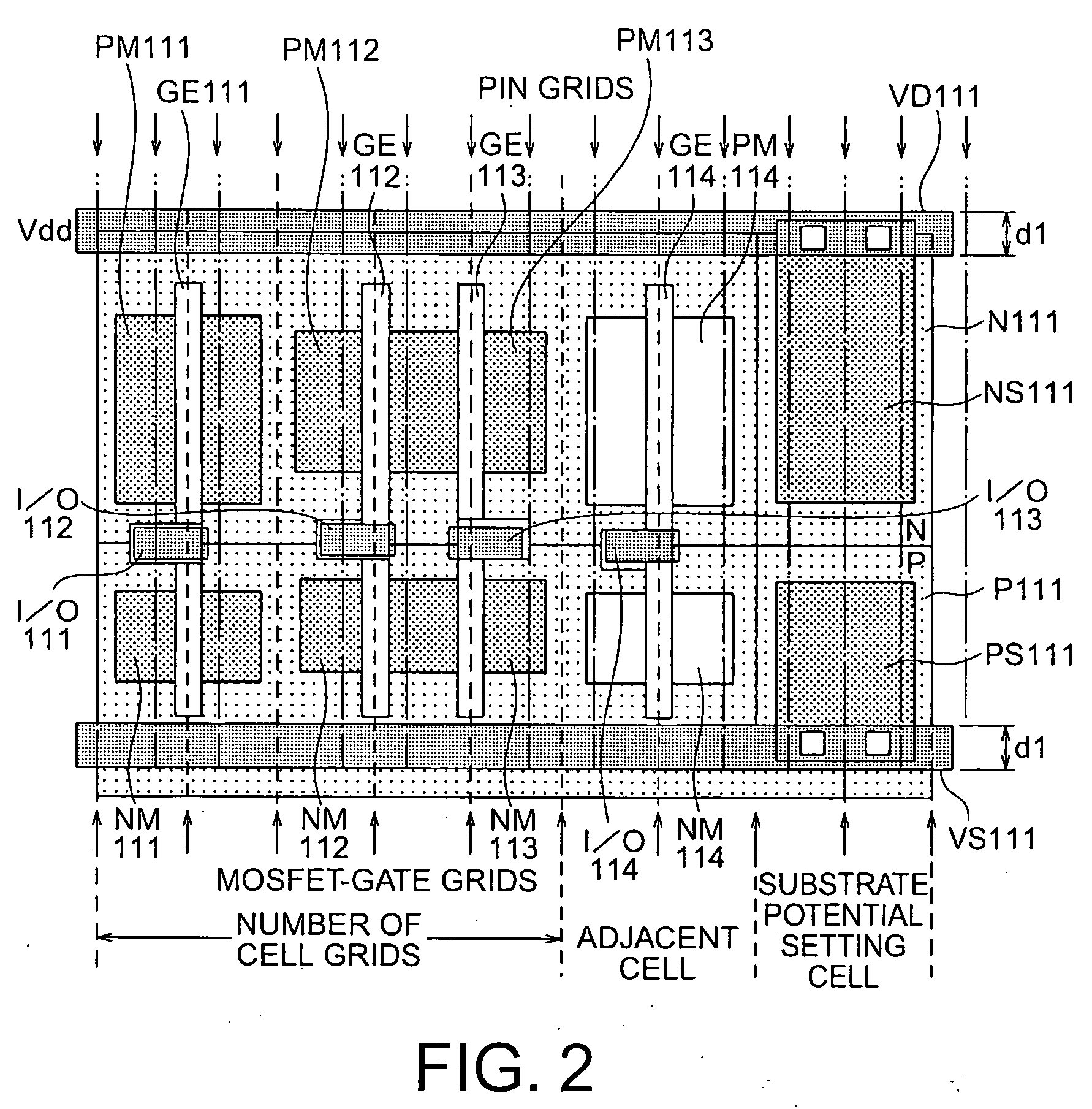Semiconductor integrated circuit and method of designing the same
a technology of integrated circuits and semiconductors, applied in the direction of semiconductor devices, semiconductor/solid-state device details, electrical apparatus, etc., can solve the problems of micropatterning difficult to perform, the demand for shortening the development time, and the abrupt increase in the circuit scale of semiconductor integrated circuits
- Summary
- Abstract
- Description
- Claims
- Application Information
AI Technical Summary
Problems solved by technology
Method used
Image
Examples
first embodiment
[0048] (1) First Embodiment
[0049]FIG. 1 is a plan view showing the arrangement of a semiconductor integrated circuit according to this embodiment.
[0050] An N-type well region N101 and P-type well region P101 are placed in a surface portion of a semiconductor substrate. A power supply voltage Vdd line VD101 and ground voltage Vss line VS101 are placed above and below, respectively, in FIG. 1, the pair of the N-type well region N101 and P-type well region P101.
[0051] In the vertical direction of FIG. 1, pin grids as a reference of a metal pin pitch are indicated by the alternate long and short dashed lines, and gate grids as a reference of the pitch of the gate electrodes of MOS transistors are indicated by the dotted lines. In this embodiment, the ratio of the pin grid pitch to the gate grid pitch is set at 2:3.
[0052] In the N-type well region N101, a gate electrode GE101 is formed on the substrate, and a P-type impurity is ion-implanted on the two sides of this gate electrode to ...
second embodiment
[0062] (2) Second Embodiment
[0063]FIG. 2 is a plan view showing the arrangement of a semiconductor integrated circuit according to this embodiment.
[0064] This embodiment is characterized in that two adjacent cells are placed, and impurity diffusion layers are additionally placed as cells for setting the substrate potential.
[0065] An N-type well region N111 and P-type well region P111 are placed in a surface portion of a semiconductor substrate. A power supply voltage Vdd line VD111 and ground voltage Vss line VS111 are placed above and below, respectively, in FIG. 2, the pair of the N-type well region N111 and P-type well region P111.
[0066] As in the first embodiment described above, in the vertical direction of FIG. 2, pin grids as a reference of a metal pin pitch are indicated by the alternate long and short dashed lines, and gate grids as a reference of the pitch of the gate electrodes of MOS transistors are indicated by the dotted lines. In this embodiment, as in the above em...
third embodiment
[0077] (3) Third Embodiment
[0078]FIG. 3 is a plan view showing the arrangement of a semiconductor integrated circuit according to this embodiment.
[0079] An N-type well region N121 and P-type well region P121 are placed in a surface portion of a semiconductor substrate. A power supply voltage Vdd line VD121 and ground voltage Vss line VS121 are placed above and below, respectively, in FIG. 3, the pair of the N-type well region N121 and P-type well region P121.
[0080] Another pair of a P-type well region P122 and N-type well region N122 are symmetrically placed with respect to the ground voltage Vss line VS121. A power supply voltage Vdd line VD122 is placed below, in FIG. 3, the N-type well region N122.
[0081] As in the first and second embodiments described above, pin grids as a reference of a metal pin pitch are indicated by the alternate long and short dashed lines, and gate grids as a reference of the pitch of the gate electrodes of MOS transistors are indicated by the dotted li...
PUM
 Login to View More
Login to View More Abstract
Description
Claims
Application Information
 Login to View More
Login to View More - R&D
- Intellectual Property
- Life Sciences
- Materials
- Tech Scout
- Unparalleled Data Quality
- Higher Quality Content
- 60% Fewer Hallucinations
Browse by: Latest US Patents, China's latest patents, Technical Efficacy Thesaurus, Application Domain, Technology Topic, Popular Technical Reports.
© 2025 PatSnap. All rights reserved.Legal|Privacy policy|Modern Slavery Act Transparency Statement|Sitemap|About US| Contact US: help@patsnap.com



